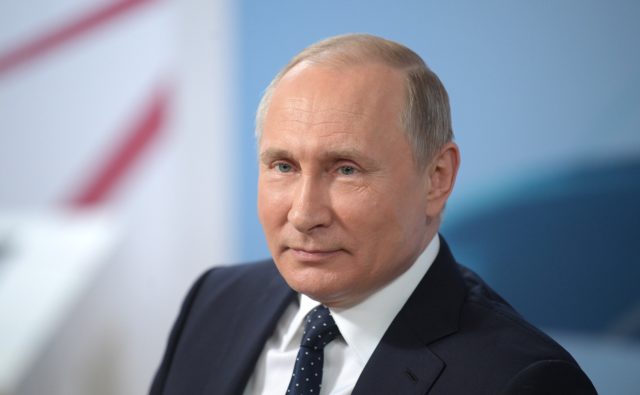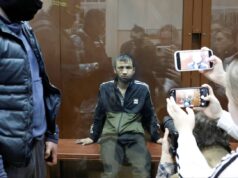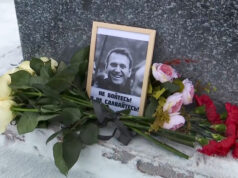
Official Russia boasts about economic progress, although the Russian economy has been nearly stagnant for the last decade as the Kremlin focuses on solid macroeconomic stability. But people do not eat macroeconomic stability. Far more important is the real income of the population, which has fallen for five years without signs of improvement. How long will the Russian people accept their government’s underperformance?
President Vladimir Putin gives three big public performances each year – his State of Russia address, a call-in program for the Russian people in the spring, and a big international press conference in December. His latest press conference took place on December 20, 2018. As he has for years, Putin emphasized the stability and sustainability of the Russian economy. Inflation was just 4.3 percent in 2018. Unemployment has fallen below 5 percent for the first time in modern Russia. Foreign trade offers steady and large surpluses, adding to the impressive international currency reserves of $469 billion at the end of 2018. Also, the government budget is in surplus and Russia’s public debt is impressively low at 12 percent of GDP.
Honestly, Putin did mention the growth rate, which was only 1.7 percent during the first 10 months, but he presented it as progress. Allegedly, the growth rate surged to 2.0 percent for the year as a whole. Since 2009, Russia has had an average annual growth rate of 0.9 percent with three years of contraction. In the medium term, virtually all forecasters predict a growth of 1.5-2 percent a year. Former Finance Minister Alexei Kudrin talks realistically about a more likely growth rate of one percent a year.
Rosstat’s Numbers
The situation for the Russian population looks far worse. According to the most recent official statistics, Russians’ real disposable incomes have fallen by a total of 11 percent during the last five years. While that appears shocking, the numbers were far worse a year ago, when the real incomes had fallen by 17 percent during the four preceding years.
This revision is noteworthy. In 2018, the Russian Federal Service of State Statistics (Rosstat) claimed that construction had increased by a measly 0.5 percent after 11 months, but for the year as a whole, the Economic Ministry claimed implausibly that it had grown by 5.3 percent, which explains the higher than expected growth rate. For years, the Russian government had been dissatisfied with the statistics from Rosstat, which has a good international reputation. The government called for a change in methodology. When Rosstat refused, in 2017 the government reduced its independence, placing it directly under the Economic Ministry. When that did not help, in December 2018 the government replaced the long-time head of Rosstat, the respected professional Alexander Surinov, with a department head from the ministry. Little surprise that statistics from previous years reflecting output, consumption, and real income have quickly improved.
A growth rate of 1.5 percent might not appear bad in the context slow-growing European countries, but the Western European economies have a GDP (gross domestic product) per capita that is four times higher than Russia’s measured in current U.S. dollars. After a growth spurt of an average of seven percent a year from 1999-2008, Russia has gotten stuck in a middle-income trap with an average growth of merely half a percent per year – and it seems unable to get out of it. Russia used to be far wealthier than China in per capita terms, but now China has caught up. Russia is also diverging economically from the West.
There are basically four reasons for Russia’s low growth rate: crony capitalism, war, oil prices, and demography.
Crony Capitalism and Capital Outflow
Russia’s fundamental problem is that the country has no real property rights because the Kremlin maintains political control over its judicial system. In a fine recent book, Property Rights in Post-Soviet Russia: Violence, Corruption, and the Demand for Law, Jordan Gans-Morse documents how property rights have been weakened since the Yukos confiscation in 2003-6. Any entrepreneur in Russia risks a year or so in pretrial detention if he offends the government.
This is not by accident but by design. Weak property rights enable the rulers to take what they want through corporate raiding with the assistance of lawless law enforcement agencies. Therefore, Russia has steady and large private capital outflows that reached $68 billion in 2018, or four percent of the $1.6 trillion economy. Foreigners see what is going on. If the locals dare not invest in Russia, foreign investors will stay away as well. Foreign direct investment was a negligible $2 billion in 2018, while four percent of GDP would be normal. This means that Russian investment is eight percent of GDP less than it would be if Russia had normal property rights.
War and Sanctions
Add to this the cost of war and Western economic sanctions. Russia started its rearmament program in 2008, when its military expenditures as assessed by the Stockholm International Peace Research Institute (SIPRI) amounted to 3.3 percent of GDP. By 2016, it had increased to 5.5 percent of GDP, which implies that Russia’s rearmament cost society an additional 2.2 percent of GDP every year. The official Russian state subsidy to Crimea is $2 billion a year. If we presume that the subsidy to the occupied Donbas region of Ukraine, with a larger population, is equally large, this would be a cost of $4 billion a year or 0.3 percent of GDP.
Among the sanctions that the United States and European Union imposed on Russia in response to the Russian military incursion in Ukraine beginning in 2014, the most economically important are the financial sanctions that started in July of that year. The International Monetary Fund (IMF) has assessed their cost at 1-1.5 percent of Russia’s GDP each year. Putin downplays the cost of the Western sanctions, claiming that they are ineffective, but at the same time he complains about them and wants them abolished.
Russia has nearly been cut off from international financing. As a consequence, Russia’s foreign debt has shrunk from $730 billion at the beginning of 2014 to $454 billion at the start of 2019. Unlike the Rosstat statistics, the Central Bank statistics are provided in such detail and so frequently that they appear quite reliable. That is, Russia paid back $276 billion that it otherwise could have deployed for investment in the national economy during years of very low international interest rates. Under normal circumstances Russia would have increased its foreign indebtedness as most other countries did.
Adding the negative costs of war and financial sanctions to the Russian economy, we find that they reduce Russia’s economy by about 3.5-4 percent of GDP each year, which is a large number. Thus, the Russian economy is unlikely to grow significantly again until the Kremlin decides to cut its military expenditures and to leave eastern Ukraine so the West lifts its sanctions.
Oil and Gas Exports
Great fluctuations in the global oil price strain the Russian economy, but the Central Bank has successfully neutralized their impact on the current account and the government budget by letting the exchange rate float with the oil price. Still, the international assets available to Russia vary greatly because in good years oil and gas comprise two-thirds of Russia’s exports and Russia has no alternative exports of note. Russia’s total exports of goods and services fell from $527 billion in 2012 when the oil price was high to $282 billion in 2016, while recovering to $509 billion in 2018 as the oil price rose.
Demographics
During the good years – the early 2000s – Russia benefited from an annual increase in its labor force of one percent a year. Now, on the contrary, Russia is expecting a decline in its labor force of one percent a year until 2030, which explains two percentage points of the lower growth in recent years. Moscow could expand its work force through a more liberal immigration policy, attracting more workers from poorer former Soviet republics, but it has failed to do so. Central Asian immigrants are not popular in Russia. While emigration is not large in numbers, many wealthy Russians and members of the entrepreneurial elite emigrate.
So, what is Putin going to do about this? The answer is nothing.
Managing the Problem
During Dmitri Medvedev’s presidency, 2008-12, he made some humble attempts at reform, but however small they were, Putin reversed them all when he returned to the presidency in May 2012. At that time, Putin issued 11 substantial and rather detailed policy decrees but, as was widely expected, hardly anything was accomplished. This was not a time of opening up but of increased repression. In May 2018, when starting his new term, Putin issued one single policy decree, which was so vague with a minimum of numbers that it hardly meant anything. In a rather Soviet fashion, it set 12 national projects on which public expenditures were supposed to be concentrated without clarifying what should be done or why it would be helpful.
Putin appears sincere in one single reform area, the World Bank’s Ease of Doing Business index. Russia had risen from ranking number 120 in 2011 to number 31 in 2018. This illustrates that Putin – like most other authoritarian rulers in the former Soviet Union – aspires to be more effectively obeyed, while caring little about economic growth. By contrast, Putin has shown no interest in reducing corruption, because Russia is a captive state. Corruption benefits him and his cronies and he rules through a kleptocracy. In the Corruption Perception Index of Transparency International, Russia ranked number 138 in 2018.
The Irony of Kleptocracy
It might appear curious that the Kremlin has not done anything to impede the massive and steady currency outflow, but the obvious explanation is that it is Putin and his cronies who benefit. The irony is that having formed an authoritarian kleptocracy, not only their enemies, but also the rulers, cannot secure their property rights in Russia. If they were to lose power, their sensible expectation is that all their loot would be confiscated by the new regime.
My assessment is that Putin and his cronies have engineered capital outflows in the order of $15-25 billion since they got their machinery of looting going around 2006. These funds are extracted primarily from Gazprom but also from other state companies and state agencies. Meanwhile, the market capitalization of Gazprom has slumped from a peak of $369 billion in May 2008 to currently $55 billion. In spite of having lost more than $300 billion, Gazprom’s CEO Alexei Miller, a Putin loyalist, stays in place, indicating that this is what Putin desires.
Putin appears oblivious to the need for reforms to speed up economic growth. In his annual press conference, he avoided the word “reform,” while “Soviet” was stated 15 times. In a very Soviet way, Putin believes in the concentration of state resources in two critical sectors. The one reform that Putin has pursued is pension reform, which means the gradual increase in the retirement age by five years to save public funds. Furthermore, Putin has increased the value-added tax from 18 to 20 percent.
Together, these two measures will increase public revenues by about 1.5 percent of GDP, but this is from the people and not for the people. Usually Putin leaves unpopular measures to the hapless prime minister Medvedev, but untypically he took ownership of the pension reform by making a special television address in August to explain it to the Russian people. While most economists approve of the pension reform, Putin is effectively demanding popular sacrifices for his aggressive foreign policy and kleptocracy.
So far, relatively mild repression has kept the population at bay. The leading opposition activist Alexei Navalny has skillfully produced well-documented and entertaining videos about the corruption of Russia’s top officials. His video about the corruption of Prime Minister Medvedev to the tune of $1.2 billion was seen by more than 28 million people on YouTube. Navalny has organized mass protests against corruption in up to 100 cities with slogans such as “Putin is a Thief.” Hundreds of protesters are regularly detained, but the protests have not had any further effects as yet.
The regime continues to organize highly restrictive elections. In the fall, four of the Kremlin’s candidates lost to nominal candidates amidst low turnout. Putin’s popularity has fallen to a new low. The Kremlin-supported polling organization, the Foundation for Popular Opinion, records that the share of Russians who say that they would vote for Putin if there were prompt elections has fallen from 74 percent in 2015 to 46 percent in January 2019. Only 33 percent of the population expressed full confidence in him. As many as 60 percent stated that they did not have confidence in Medvedev and only 27 percent expressed confidence.
While Russia’s economic situation appears predictably stable and stagnant, the question is rather how long the Russian population will tolerate a regime that performs so poorly.
Anders Åslund, Ph.D., is a senior fellow at the Atlantic Council and author of the forthcoming book Russia’s Crony Capitalism: The Path from Market Economy to Kleptocracy.





